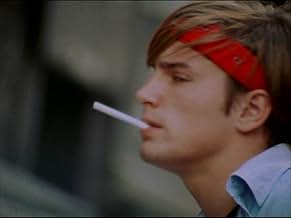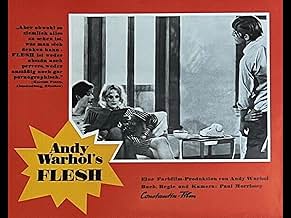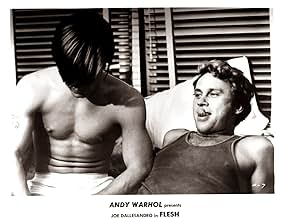AVALIAÇÃO DA IMDb
5,7/10
2,7 mil
SUA AVALIAÇÃO
Um homem desesperado por dinheiro e sem renda começa interagir com uma variedade de clientes e traficantes.Um homem desesperado por dinheiro e sem renda começa interagir com uma variedade de clientes e traficantes.Um homem desesperado por dinheiro e sem renda começa interagir com uma variedade de clientes e traficantes.
- Direção
- Roteirista
- Artistas
- Prêmios
- 1 vitória no total
Roberto D'Allesandro
- Boy in the Street #2
- (não creditado)
Jed Johnson
- Solicitor
- (não creditado)
Avaliações em destaque
It seems inhumane to describe someone as a work of art but in the Warhol
Art Sphere there seems little other way to describe Joe Dallesandro in
"Flesh". His body is displayed constantly in the nude, more consistently
naked than any other actor I can think of in American film history.
Warhol/Morrissey (the authorship of the movie remains contentious though
Morrisey is the credited director, the film rides under the "Andy
Warhol's" banner) objectify and expose every part of Dallesandro's
hustler in the film. He was truly the first sex symbol of the 70s. It
was only in "Flesh" he was so un-self-conscious and innocent though
always with survivalist and self-serving cunning. Joe (the character) is
an interesting kafka-esque (unable to control the world around oneself,
prone to the ebb and flow of circumstance and external control) figure
in the midst of a collage of underground culture figures of the 60s from
drag artistes to quivering tricks. Its a high camp affair at times but
Morrissey has a loving camera when it comes to Joe. Joe's beauty is
vividly captured and the fly-on-the-wall style story of a day in his
life remains engaging a
Art Sphere there seems little other way to describe Joe Dallesandro in
"Flesh". His body is displayed constantly in the nude, more consistently
naked than any other actor I can think of in American film history.
Warhol/Morrissey (the authorship of the movie remains contentious though
Morrisey is the credited director, the film rides under the "Andy
Warhol's" banner) objectify and expose every part of Dallesandro's
hustler in the film. He was truly the first sex symbol of the 70s. It
was only in "Flesh" he was so un-self-conscious and innocent though
always with survivalist and self-serving cunning. Joe (the character) is
an interesting kafka-esque (unable to control the world around oneself,
prone to the ebb and flow of circumstance and external control) figure
in the midst of a collage of underground culture figures of the 60s from
drag artistes to quivering tricks. Its a high camp affair at times but
Morrissey has a loving camera when it comes to Joe. Joe's beauty is
vividly captured and the fly-on-the-wall style story of a day in his
life remains engaging a
Flesh is the first film of a trilogy by Paul Morrissey and Andy Warhol, and is perhaps the first attempt to create an icon of desire out of a male leading role. Although the film is focused on an uncomplicated character development of Joe (Joe Dallesandro), a gentle and subtly unhappy hustler, it depicts him as a passive and ambivalent object, who, in spite of a semi-evident sense of self-control, is possessed, shaped, and evaluated entirely by others. Joe is a young and somewhat naive Adonis who exudes comfort and beauty in his independence, but he works the streets to support his lesbian wife and her girlfriend. He is restlessly bored by an artist/customer's speeches on Greek athletic sculpture and 'body worship', but he sells his nudity anyway. He regards the increasing advances of his homosexual friend with ambivalence, but lets them happen nonetheless. This passivity dominates the film and succeeds in creating a visceral element to Dallesandro's appeal: not only is he desired, he is had.
Perhaps the film's most interesting element is the balance of its obviously experimental nature with its palpable directness. The snappy editing and fragmented dialogue make it fresh and 'real', yet it manages not to rely on the clichéd abstractness of art-films. It is rough, and indeed a weaker effort than Trash or Heat, but nonetheless presents a collection of perfectly plausible characters in a light of almost absolute neutrality.
Perhaps the film's most interesting element is the balance of its obviously experimental nature with its palpable directness. The snappy editing and fragmented dialogue make it fresh and 'real', yet it manages not to rely on the clichéd abstractness of art-films. It is rough, and indeed a weaker effort than Trash or Heat, but nonetheless presents a collection of perfectly plausible characters in a light of almost absolute neutrality.
The title practically says it all, and that's all you'll need to be expecting to enjoy this movie. What you get when you watch this film is tons of the beautiful, masterpiece that is Joe Dallesandro all over the screen. It is a day in the life of his character, a married bisexual prostitute, and how his life ties in with all the people around him and all the people he does business with. It is a very interesting and well done film for how well the actors play it out. They act as if it is just an ordinary day and they don't even know a camera is filming them which makes it seem so real. Joe Dallesandro is another reason why this film works out well.
Now, I'm not saying that the main purpose was to make us want to jump into the screen, pull him out and play with him, but goodness was that boy beautiful, and I certainly wanted to do just that. It might be just for his looks that the reason we care to watch his character's day play out so much is because he's so incredibly gorgeous, but in any matter it still makes us care what happens to the character, which is something any film should try to do. It becomes an interesting tale because of how we see what amazing things he's able to do with his body and how amazing his body looks doing them, such as the Greek pose photoshoot and how him playing with and feeding his child in the nude is still sweet and charming whilst being devilishly mouthwatering.
The movie is not meant to be a landmark among film history. It's a run-of-the-mill film about an average day that is made into an excellent story and an excellent movie overall because of how much we enjoy seeing the actors and actresses take part in it. The dialog keeps your attention, the story keeps your attention and Joe Dallesandro's existence keeps your utmost attention. I suggest you see it in the right sense and you'll be able to have fun with it and enjoy it.
Now, I'm not saying that the main purpose was to make us want to jump into the screen, pull him out and play with him, but goodness was that boy beautiful, and I certainly wanted to do just that. It might be just for his looks that the reason we care to watch his character's day play out so much is because he's so incredibly gorgeous, but in any matter it still makes us care what happens to the character, which is something any film should try to do. It becomes an interesting tale because of how we see what amazing things he's able to do with his body and how amazing his body looks doing them, such as the Greek pose photoshoot and how him playing with and feeding his child in the nude is still sweet and charming whilst being devilishly mouthwatering.
The movie is not meant to be a landmark among film history. It's a run-of-the-mill film about an average day that is made into an excellent story and an excellent movie overall because of how much we enjoy seeing the actors and actresses take part in it. The dialog keeps your attention, the story keeps your attention and Joe Dallesandro's existence keeps your utmost attention. I suggest you see it in the right sense and you'll be able to have fun with it and enjoy it.
I guess only a selected number of audience members really had any interest in watching how a male hustler in New York operates but I'd be willing to bet that even these brave souls were turned off by the irritating patchwork technique and deliberately muffled sound recording on display here; the fact that these inherent 'defects' were a direct result of the film's low-budget/underground/experimental nature is, I'd say, beside the point. Anyway, for those so inclined, the film features extensive male nudity and Joe Dallesandro, understandably, became an underground and gay icon!
The episodic structure showing the day-to-day routine of the hustler protagonist offers a couple of mildly interesting scenes: his meeting with (and eventually posing for) an eccentric elderly artist; the one where Dallesandro expresses his views on his unusual line of work and delineates his particular modus operandi to a couple of prospective 'colleagues' including perhaps the unlikeliest of hustlers a bespectacled nerd! Perhaps mercifully, the film ran for only 89 minutes against the IMDb's claim that its complete length is 105 (but the latter could well be a mistake)!
I had watched a few other of Warhol's 'movies' and this one is decidedly not as satisfying as the most tolerable example I've run into yet, BAD (1977), and only slightly better than the likes of MY HUSTLER (1965) which were mostly a strain to sit through. The fact that this was only the first part of a trilogy did not augur well but, as the saying goes, you gotta to do what you gotta do and the other two 'chapters' had to follow in quick succession...
Despite my generally negative reaction to it, FLESH is nevertheless still valuable as a 1960s time capsule and as a prototype of the Underground scene of that era, both cinematically and in real life. For the record, an image of Dallesandro from this film adorns the sleeve of The Smiths' self-titled 1984 debut album and transsexual Candy Darling (who appears here rather unremarkably) was immortalized in "Candy Says", the opening track of The Velvet Underground's eponymous 1969 album. Although the latter band is my all-time favorite, and one of the reasons for this is that, through their sheerly unique and ground-breaking music, they described a lifestyle so utterly different from my own, this is truly a case where I'd much rather experience something aurally instead of visually!
The episodic structure showing the day-to-day routine of the hustler protagonist offers a couple of mildly interesting scenes: his meeting with (and eventually posing for) an eccentric elderly artist; the one where Dallesandro expresses his views on his unusual line of work and delineates his particular modus operandi to a couple of prospective 'colleagues' including perhaps the unlikeliest of hustlers a bespectacled nerd! Perhaps mercifully, the film ran for only 89 minutes against the IMDb's claim that its complete length is 105 (but the latter could well be a mistake)!
I had watched a few other of Warhol's 'movies' and this one is decidedly not as satisfying as the most tolerable example I've run into yet, BAD (1977), and only slightly better than the likes of MY HUSTLER (1965) which were mostly a strain to sit through. The fact that this was only the first part of a trilogy did not augur well but, as the saying goes, you gotta to do what you gotta do and the other two 'chapters' had to follow in quick succession...
Despite my generally negative reaction to it, FLESH is nevertheless still valuable as a 1960s time capsule and as a prototype of the Underground scene of that era, both cinematically and in real life. For the record, an image of Dallesandro from this film adorns the sleeve of The Smiths' self-titled 1984 debut album and transsexual Candy Darling (who appears here rather unremarkably) was immortalized in "Candy Says", the opening track of The Velvet Underground's eponymous 1969 album. Although the latter band is my all-time favorite, and one of the reasons for this is that, through their sheerly unique and ground-breaking music, they described a lifestyle so utterly different from my own, this is truly a case where I'd much rather experience something aurally instead of visually!
Although the film opens with the credit "Andy Warhol Presents", it was actually written, photographed and directed by cult film-maker Paul Morrissey (according to Morrissey, all Warhol provided was money and publicity).
Joe Dallesandro (immortalised as "little Joe" in the Velvet Underground song "Walk on the Wild Side") plays Joe, a slightly dim-witted male prostitute, who is supporting his bisexual wife and baby. His wife wants him to come up with $200 for her girlfriend's abortion. We basically follow Joe around as he encounters various characters willing to help him, including an artist who wants to pay him to pose nude, and Warhol "superstars" Candy darling and Jackie Curtis.
Despite being amateurishly shot, with countless technical errors, the most annoying of which is a very badly-recorded soundtrack, the film is fascinating due to it's delving into a world rarely seen on mainstream screens, which probably doesn't exist anymore. Although many scenes do go on for too long, it's too startling to be dull. Fans of Joe Dallesandro will no doubt enjoy his frequent exposure (he provides most of the flesh of the title).
If you're a fan of cult or underground films, you'll not want to miss this. It was followed by "Trash" (1970) and "Heat" (1972) to form a loose trilogy.
Joe Dallesandro (immortalised as "little Joe" in the Velvet Underground song "Walk on the Wild Side") plays Joe, a slightly dim-witted male prostitute, who is supporting his bisexual wife and baby. His wife wants him to come up with $200 for her girlfriend's abortion. We basically follow Joe around as he encounters various characters willing to help him, including an artist who wants to pay him to pose nude, and Warhol "superstars" Candy darling and Jackie Curtis.
Despite being amateurishly shot, with countless technical errors, the most annoying of which is a very badly-recorded soundtrack, the film is fascinating due to it's delving into a world rarely seen on mainstream screens, which probably doesn't exist anymore. Although many scenes do go on for too long, it's too startling to be dull. Fans of Joe Dallesandro will no doubt enjoy his frequent exposure (he provides most of the flesh of the title).
If you're a fan of cult or underground films, you'll not want to miss this. It was followed by "Trash" (1970) and "Heat" (1972) to form a loose trilogy.
Você sabia?
- CuriosidadesUK censor John Trevelyan was wary of issuing the film a cinema certificate and suggested to the distributors that the film be shown on a club basis. When it was initially shown at the Open Space Theatre in London in February 1970 the cinema was raided by police who attempted to seize the film, leading Trevelyan himself to hastily rush to the cinema and vigorously defend the movie against possible prosecution, calling the police action 'unjustified and preposterous'. In the light of this incident Trevelyan was able to grant the film an uncut 'X' certificate.
- Erros de gravaçãoDuring a scene with the go-go dancer, Candy and Jackie alternately call her by the character's first name (Terry) and that of the actress playing her (Geri Miller).
- Citações
Joe, the Hustler: How am I supposed to make any money without clean underwear?
- Cenas durante ou pós-créditosThe opening credits run sideways and list Warhol's name, the title, the main cast members, and that it was written, photographed and directed by Paul Morissey.
- ConexõesEdited into Porno & libertà (2016)
- Trilhas sonorasMakin' Wicky Wacky Down in Waikiki
Performed by Sophie Tucker.
Principais escolhas
Faça login para avaliar e ver a lista de recomendações personalizadas
- How long is Flesh?Fornecido pela Alexa
Detalhes
- Data de lançamento
- País de origem
- Idioma
- Também conhecido como
- Andy Warhol's Flesh
- Locações de filme
- Greenwich Village, Nova Iorque, Nova Iorque, EUA(At the apartment of critic David Bourdon)
- Empresa de produção
- Consulte mais créditos da empresa na IMDbPro
Bilheteria
- Orçamento
- US$ 4.000 (estimativa)
- Tempo de duração1 hora 29 minutos
- Mixagem de som
- Proporção
- 1.37 : 1
Contribua para esta página
Sugerir uma alteração ou adicionar conteúdo ausente



























